Vol 1 No. 6 TROPIC LIGHTNING NEWS April 8, 1966
Index
More Troops Land at Cu Chi
The 25th Inf. Div. flexed its military muscle anew last week when more than
2,000 "Tropic Lightning" troops arrived at Vung Tau aboard the USNS Gordon.
Met by Air Force C130s, the troops were transported to Tan Son Nhut Air Force
Base outside Saigon and further transported to their base camp at Cu Chi by
CH-47 Chinook helicopters.
The soldiers are the latest contingent of the division presently based in the
Republic of Vietnam. The newly arrived men arrived five days after Maj. Gen.
Fred C. Weyand, division CG, landed in Vietnam to assume command of the 25th
Infantry Division's soldiers in the III Corps Tactical Zone.
Last Saturday's arrival marked the completion of the division soldiers'
6,000-mile move from Hawaii to Vietnam, although the 1st Bde.Task Force still
remains in the Aloha State.
The incoming contingent included the remaining elements of Support Command
under Colonel Herbert S. Lowe, and Division Artillery, commanded by Colonel
Daniel B. Williams.
The latest arrival climaxes the deployment of "Tropic Lightning-aires" to
Vietnam beginning in December when 3d Bde. arrived at Pleiku, 240 miles north of
Saigon. They took over a bivouac area secured by elements of the 1st Cav.
(Airmobile) Div. as part of the U.S. challenge to six or seven North Vietnamese
regiments reported operating in the mountains.
Second Bde. arrived in January and is presently in the Cu Chi area.
| Members of 25th Avn. Bn. arrive at Cu Chi. |
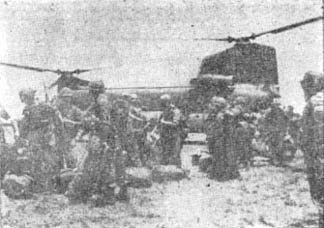 |
Third Brigade Greets CG on First Visit
Maj.Gen. Fred C. Weyand, division CG, arrived at Pleiku lest week for his
first official visit to the 3d Bde. since assuming command of the division in
Vietnam.
General Weyand, who received extensive tours and briefings of the brigade and
its operations since its arrival here last December, had previously visited the
Pleiku area in the middle of January when the division was still in Hawaii.
The general was greeted upon his arrival by Colonel Everette A. Stoutter, 3d
Bde. commander, at the Pleiku airstrip. In addition to the round-robin tour of
the Brigade, General Weyand received a complete rundown on Operation Garfield,
which terminated on March 25th.
He was also shown a sample of the weapons and materials, including drugs and
medical supplies, captured during the recently completed operation.
During the morning, General Weyand was briefed by Maj. Herbert Evans, of 3d
Spt. Bn. (Provisional), Capt. Charles Bernitt, B Co., 725th Maint. Bn., and Lt.
Col. George Scott, 2/35th CO. Colonel Scott gave a briefing on the present road
clearing operation on Highway 19 from his command post at Mang Yang Pass.
In the afternoon, General Weyand went to Duc Co, where he was greeted by the
brigade staff.
The 25thDivision commander was also greeted during his Pleiku visit by Maj.
Gen. Harry Kinard, 1st Cav. Div. commander, who arrived midway through a series
of briefings on recent brigade operations.
General Weyand was helilifted to the 1/14th Inf. operations area for his
return to Cu Chi.
Division Soldiers Sweep Out Hau Nghia in Spring Cleaning
"Tropic Lightning" soldiers did some spring house cleaning in the village of
Vinh Cu in Hau Nghia Province Saturday, picking up 37 Viet Cong suspects and
uncovering cellars sometimes used to hide Viet Cong and their weapons.
The search-and-clear operation was conducted by A Co. , 1/27th Inf.,
commanded by 1Lt. Robert J Pope.
Vinh Cu, located rear the outskirts of the division's base camp, has been
receiving assistance in the form of medical and food distributions since the
arrival of 2d Bde. in January.
The 65th Engr. Bn. has been working in the Laterite pits near the village of
Vinh Cu for the last two months. Laterite, a rock decomposition of aluminum and
iron, is used to surface the roads in the division's base camp area.
The Viet Cong have committed terrorist acts in the village area to discourage
the engineers and to keep the villagers from cooperating with the division.
Just two days ago, a Claymore mine was set off, killing a 12-year-old village
boy and inflicting light casualties on the engineer battalion.
During Saturday's house cleaning session, division soldiers found cellars
which in some cases had been converted into tunnel systems providing possible
shelter for Viet Cong and their weapons.
During the entire operation, the villagers of Vinh Cu continued their daily
chores, took mid-morning snacks, weaved bamboo mats or sold soft drinks to the
searchers from their vending machines.
Former Gunner Receives DFC
Specialist Four Albert E. Mosher, a member of B Btry., 1/8th Arty., has been
given the nation's fifth highest award for valor. The 19-year-old senior
switchboard operator was presented with the Distinguished Flying Cross last week
for action with Co. A, 82nd Avn. Bn., where he served as an aerial door gunner
last year.
According to the citation, Mosher, of Breedsville, Mich., was serving aboard
an armed helicopter last June 10.
"His helicopter joined a formation of troop carriers and proceeded to Ben Cat
where Vietnamese troops were loaded and carried to a landing zone near the
encircled village of Dong Xoai. The initial landing was made without incident.
"A second lift into the same landing zone was attempted, but could not land
because of an intense battle between the troops of the first lift and the Viet
Cong. Since a landing at the site was impossible, an alternate landing zone was
selected. When the formation approached for a landing, the Viet Cong drove a
herd of water buffalo across the site, forcing the helicopters to land in a
confined area. (Sp4) Mosher's ship then became the focal point of intense
hostile fire from nearby foxholes and buildings.
"After his ship was severely damaged, the pilot seriously wounded, and two
Vietnamese soldiers attempting to dismount were cut down by heavy fire, (Sp4)
Mosher spotted the Viet Cong machinegun near his helicopter. With complete
disregard for his personal safety he stood fully exposed in the doorway of his
aircraft and returned a barrage of fire on the insurgent positions, forcing them
to subside.
"This action permitted the Vietnamese troops on his craft to dismount safely,
and prevented further damage from the small arms fire in the landing zone. He
continued to deliver devastating fire until his helicopter was out of range of
the Viet Cong weapons.
"He then turned his attention to the pilot, who was bleeding heavily from
multiple wounds. Using his belt as a tourniquet, he succeeded in stopping the
flow of blood.
"After administering first aid to the stricken pilot, he returned to his post
and proceeded to advise his commander of suspected Viet Cong positions en route
to the medical collection point.
"Through his courage and initiative in the face of mortal danger, he
prevented his helicopter from certain destruction, and saved the life of his
pilot.
"The heroic actions of (Sp4) Mosher were in keeping with the highest
traditions of the military service and reflect great credit upon himself, his
unit and, the Army."
CONGRESS OKAYS DUTY-FREE GIFTS
American armed forces in Vietnam may now send gifts valued at no more than
$50 back to the United States duty free.
The change raises the limit from the former $10 duty-free ceiling in effect
until President Johnson signed Public Law 89-368. Provisions of the law, in
order to take advantage of the new limit, require that all gifts be marked on
the outside of the package: "P. L. 89-368 Value Less Than Fifty (50) Dollars."
Additionally, only items purchased through authorized armed forces agencies,
such as post exchanges, may be admitted duty free through United States Customs.
| A REMINDER Monday is the day for your anti-malaria pill. |
| Mj. Gen. Byron L. Steger (center) examines enemy surgical instruments captured by 3d Bde. Escorted by Dr. (Capt.) William R. Gardiner (right), brigade surgeon, USARPAC surgeon and CG of Tripler Army Medical Center was on a tour of medical facilities in Vietnam. |
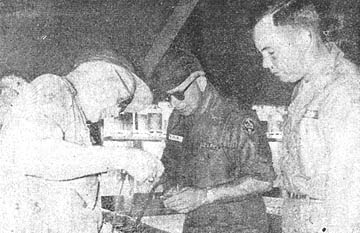 |
Page 2 TROPIC LIGHTNING NEWS April 8, 1966
Cobra to Be Successor To Armed Iroquois
The streamlined, high-speed UH-1H "Huey" Cobra helicopter will soon replace
the five-year-old UH-1B Iroquois as the Army's workhorse armed helicopter,
according to an Army announcement.
It will do the job of its predecessor - escort troop-carrying helicopters and
provide suppressive fire on landing zones until the Advanced Aerial Fire Support
System becomes operational.
The Cobra was developed by the Bell Helicopter Co. to meet the Army's needs
for an interim weapons ship fitted with an improved armament system and
available for immediate low-cost deployment.
Its high-performance fuselage gives the Cobra greater range, speed,
maneuverability, and weapons payload than the UH-1B, also made by Bell. It
uses, however, the same transmission, engine, and rotor system to provide
similar operational characteristics and parts interchangeability. Little pilot
and mechanic retraining and few supply changes will be needed. The Cobra has a
crew of two; the gunner sits directly forward of the pilot and mans a General
Electric Minigun mounted in a turret beneath the nose of the fuselage. Short
wings permit the mounting of grenade launchers, rockets, and other weapons.
First deliveries of the Cobra are scheduled for mid-1967. They will be
deployed as soon as possible, gradually replacing the UH-1B. (ANF)
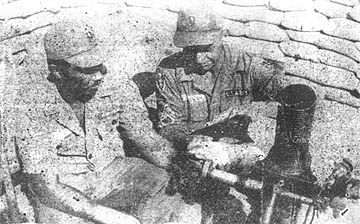 |
When the man said "lightning never strikes twice" he obviously hadn't met Sp5 Felecisimo Porquis (I.) and PSgt Lawrence Koskey. The two men were each struck twice by a bolt of 25th Infantry Division "Tropic Lightning". Sergeant Koskey, of Culver City, Calif., was with the 2/27th Inf. Wolfhounds in Korea during 1950-51. He is now a wolfhound with Co. B, of the 2d Battalion. Koskey, NCOIC of the mortar platoon, shows an 81mm mortar round to Specialist Porquis, of Kauai, Hawaii, who was with 14th Infantry in Korea. |
IRS Rules on Viet Taxes
Armed forces personnel who serve in an area designated a "combat zone" can
exclude from income tax all or part of their military compensation. Thus,
servicemen who presently serve in Vietnam or adjacent Waters or have served
there during 1964 or 1965 are eligible for this income tax benefit.
An exclusion from gross income is allowed for any month served in Vietnam and
for time spent in a hospital as a result of such service. Service for any part
of a month - even two or three days - will permit servicemen to exclude pay
received for the entire month. Enlisted men can exclude all such pay but
commissioned officers can exclude only up to $200 a month.
The exclusion is computed by disbursing and finance officers and is omitted
from wages shown on Form W-2, the Wage and Tax Statement.
Income tax returns are not due until 180 days after combat zone veterans
leave Vietnam. If they are hospitalized outside the U.S. as a result of Vietnam
service, returns are not due until 180 days after they are released from the
hospital. The additional time for filing returns would not be extended because
of hospitalization in the U.S., but the military pay exclusion would be
continued - regardless of where Vietnam veterans are hospitalized.
No penalties or interest is charged on tax returns filed within the 180 day
period. If the disbursing and finance officer failed for one reason or another
to omit combat zone pay from Forms W-2, amended returns or claims may be filed
with IRS. Amended returns should be marked simply, "COMBAT ZONE." (AFPS)
GENERAL SPEAKS TO WIDE-EYED KIDS
More than 400 youngsters attending the Minh Tan school in the small,
relocation village of Bac Ha near the Division's base camp have a new American
hero: Maj. Gen. Fred C. Weyand, division CG.
The towering commander, who stands 6 feet 4 inches tall, passed out awards to
the most outstanding students from the elementary grades to high school
Upon his arrival for the ceremonies Sunday morning, General Weyand was
greeted by cheers and applause from students formed up in two lines outside the
school.
Before the ceremonies began, the youngsters packed into the auditorium, along
with many of the village elders, to get another look at the American officer.
Stretching the width of the stage was a sign which read: "All students of
Minh Tan School are happy to receive the top American officers."
Father Tran Van Phan opened the ceremonies by saying that the Minh Tan
students were happy that Americans had helped to "liberate them from a patrol of
Viet Cong."
His assistant, Father Dao Nguyen Thong, thanked the Americans and hoped that
the American and Vietnamese people will "be tied closer together."
General Weyand then proceeded to the stage where he was greeted by hundreds
of younsters amazed at his tremendous stature.
He remarked, "This is my first meeting with the people of Vietnam. It is
wonderful that the meeting is with young people.
"America and Vietnam are the same," he added, "because our future, as yours,
lies in the hands of our young people."
The ceremonies included a variety of dances performed by the youngsters of
Minh Tan school. The first such routine was "the dance of the twist," a close
resemblance to the American version of the hip-twisting and back-bending dance.
It was followed by dances of the paradise, angels, harvest time, old
Vietnamese soldier and Vietnamese hat. In addition to the awards given to the
outstanding youngsters, they received brass plaques, which read: "To the most
outstanding...from the 2nd Brigade, 25th Infantry Division."
| Maj. Gen. C. Fred Weyand, division CG, presents diplomas and awards to outstanding students in the Minh Tan School at Bac Ha Sunday. |
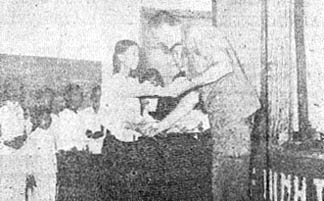 |
Editorial: One Nation Under Law
American military men and women have learned, as champions of freedom, that
liberty and the rule of law go hand in hand. They keep this in mind as America
prepares to observe May 1 as Law Day, U.S.A.
The year 1966 is the 175th anniversary of the Bill of Rights and the 190th
anniversary of American independence. "These two significant events in American
history," said President Johnson, "serve to remind us that the great individual
rights we value so highly carry with them corresponding obligations of citizenship: to obey the law, recognize the
rights of others, resolve grievances by lawful means, support law enforcement
agencies, encourage law obedience by others, practice and teach patriotism, and
defend our country."
The expression rule of law means a law system. "In its simplest form," said
Chief Justice Earl Warren, "a law system is a set of rules to govern and guide
human conduct so as to avoid conflicts and a court system for peaceful decision
of the inevitable disputes that will arise."
Under the rule of law, men have rights as individuals, and both individuals
and their governments are subject to law. The rule of law protects the rights
of people, assures the freedom and dignity of the individual, makes order and
just ice possible and allows the greatest possible degree of human freedom,.
The rule of law has helped our country attain its present position of
leadership. The fact that the United States is the wealthiest and most
productive country in the world can be attributed in part to our legal order.
Under the rule of law, Americans are free to exercise their initiative and
resourcefulness, to develop their talents and skills as fully as possible, to
get as far ahead in life as their own capabilities allow, to pursue their own
destiny.
The American serviceman is personally involved in a struggle in which the
central issue is tyranny versus liberty, or the rule of communist dictators
versus the rule of law. This is a struggle that requires resources of heart and mind - personal devotion to
liberty under law that comes from the heart and genuine respect for the right of
all peoples to equality under the law.
The United States is committed to a role of leadership in preserving the
freedom of the free world. As a defender of liberty, every American serving in
the armed forces is under a specific obligation to respect and promote the rule
of law, because he knows what is at stake and values his own freedom under the
rule of law.
| The TROPIC LIGHTNING NEWS is an authorized publication of
the 25th Infantry Division. It is published weekly for all division units
in the Republic of Vietnam by the Information Office, 25th Infantry Division,
APO U.S.1 Forces 96225. Army News Features, Army Photo Features and Armed
Forces Press Service material are used. Views and opinions expressed are
not necessarily those of the Department of the Army. Printed in Saigon,
Vietnam, by Dai Doan Ket Publishing Company. Maj. Gen. Fred C. Weyand . . . . Commanding General Maj. William C. Shepard . . . . . Information Officer Sp5 Dale P. Kemery . . . . . . . . . Editor |
Page 3 TROPIC LIGHTNING NEWS April 8, 1966
Circle Pines Ends; 171 VC Dead
A violent pre-dawn attack on Co. A, 1/27th Inf. marked on the last day of
operation "Circle Pines" 10 miles north of Cu Chi.
171 dead VC by body count were counted by elements of the 2d Bde. Fifty-six
of the dead were killed in the last 24 hours of the operation in Hobo Woods near
Trung Lap.
Action began at approximately 6 p.m. Monday when armed helicopters began to
receive heavy automatic weapons fire at an altitude of 4,000 feet. In checking
the lightly wooded area five kilometers north of Trung Lap, a force of
approximately 50 VC were spotted among the trees. Immediate artillery fire was
poured on the fleeing Viet Cong, followed by three brigade-directed jet
strikes. Prior to darkness 12 bodies, attributed to the air strikes, were
counted on the ground, with another forty estimated killed. Elements of 1/5th
moved on the location and received sporadic fire, but darkness allowed the VC to
break contact before division soldiers closed with the enemy.
Approximately two kilometers northwest of Trung Lap, Co. A, 2/27th Inf.,
pulled into a wooded area and set up a perimeter for the night.
It was quiet early in the evening as the listening post (LP) and ambush
patrols set out. Shortly before midnight several probing attacks were launched
against the patrols and LP's with action continuing for an hour. It died down
until 4:15 when an estimated VC company hit one corner of the perimeter, but was
driven back by small arms and automatic weapons fire. 16 VC bodies were left
behind.
At 5 a.m, bugles sounded on opposite sides of the perimeter and a withering
barrage of 60mm mortar, 57mm recoilless rifle, grenade and small arms fire was
directed on the company. A few minutes later a full scale attack was launched
from three sides. Twice the enemy moved almost to within hand-to-hand fighting
distance before being driven back. Several VC finally managed to break into one
defensive trench and, before dying, killed one of their own men, who had been
captured in an earlier action.
In the initial stages of the attack, the artillery forward observer became a
casualty. Although twice wounded, his radio operator, a private first class who
had never adjusted artillery, called in over 500 rounds of 105mm howitzer fire.
So accurate was the fire that it frequently came within a hundred feet of the
friendly defensive positions, taking a heavy toll of Viet Cong.
The attack lasted for 15 minutes before the artillery and defensive fire
drove the VC back. In spite of the heavy fire and aided by darkness, they
carried with them many of their dead. A check at dawn revealed 28 bodies left
behind, in addition to large amounts of equipment, grenades, shells, small arms,
and ammunition.
With the cessation of the attack, relief forces from 27th Inf. and 5th inf.
arrived to pursue the Viet Cong. But darkness and dense woods enabled the VC to
break contact.
|
AF NCO Reups for Army Duty |
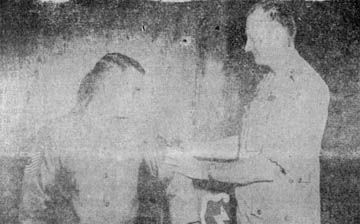 |
| Maj. Gen. Fred C. Weyand pins on the stripes of senior master sergeant (E-8) for Joe D. Willard, USAF liaison with G-3 Air. |
Senior Master Sergeant Joe D. Wlllard, an Air Force sergeant serving as
assistant to the Air Force Liaison officer, 25th infantry Division, was promoted
to his present rank last week by Maj. Gen. Fred C. Weyand, division CG.
General Weyand presented the stripes to Sergeant Willard and commended the
closeness of the Army and Air Force at the local level.
This was the second "two-service" ceremony for the two. On March 1, 1965,
General Weyand administered the oath of enlistment to Sergeant Willard when the
division was still located in Hawaii."
A-nine-year veteran of the Air Force, the newly promoted senior master
sergeant served in the Army from February 1948 to February 1957.
"This is a first for me," the general commented as he presented the stripes
to the Air Force sergeant, "but it's always a pleasure to promote a soldier - an
airman in this case."
General Weyand told the sergeant and members of his division staff gathered
for the
ceremony that he's happy to take the 25th Division into combat with the support
furnished
by the Air Force. "I wouldn't want to fight here without you people with me,"
the general added.
Where The Mail Is
Just like little, old peddlers opening their packs. Except that one long ton
of mail a day, 365 days a year, isn't too jolly a task to be ho-hoing about
around Pleiku.
But facing 4,000 irate soldiers from the 25th Infantry Division's 3d Brigade
who haven `t received any mail is hardly a pleasant prospect either, so the
postal section quietly goes about its business. It is the processing the 2,200
pounds of letters, packages, newspapers and magazines, frequently doing their
jobs to the smell of burning midnight oil.
The men who staff the brigade's air post office (APO) unit are the center of
attraction for an enterprise so bustling that many a small businessman would
turn green with envy.
More than 2,500 letters a day pour into the APO from 13 units, making the
avalanche of mail going out almost as great as the long, grey line of swollen
postal sacks coming in.
But besides the whump! Of dropping mail sacks and the clicks and thuds of
packages being sorted into cubbyholes, there is also the rustling of money
changing hands. In the first 26 days of March alone, postal patrons handed
clerks $513,000 for money orders which cost them more than $1,700 in fees.
But revenue is not limited to money orders. Surprisingly enough, more than
$1,400 in Stamps were sold last month, in spite of the free privileges granted
Vietnam-based servicemen. But only a handful of stamps went on foreign-bound
letters. Most of the remainder went on packages of Vietnamese dolls and ao
dais, the native women's dresses.
Mindful of their limited facilities at the brigade's "Hilton on the hill,"
the postal personnel have busied themselves in their spare time with adding an
annex to process nothing but selling and issuing money orders, and are presently
building a mail "dock" to handle the many mail bags which flow through the APO
daily.
Upjohn Gives MEDCAP Drugs
Second Bde.'s medical civic action program (MEDCAP) has been given a shot in
the arm from the Upjohn Company, of Kalamazoo, Mich. The large pharmaceutical
firm, operating through the Catholic Relief Society, has donated badly needed
medical supplies to continue treating the Vietnamese villagers who live near the
brigade's base camp at Cu Chi.
Capt. Gerald R. Herrin, of Dallas, Ore., brigade surgeon, said that Upjohn
has donated all types of medical supplies. "We have received hard-to-get skin
preparations as well as needed antibiotics," he remarked.
"Vitamins are also needed because the Vietnamese people often have inadequate
diets. We have received plenty of these from Upjohn."
Most of the medical supplies for the Vietnamese are received from the United
States Overseas Mission. Civilian firms like Upjohn and charitable
organizations such as the Catholic Relief Society have helped extensively.
The medical supplies are used in the MEDCAP visits conducted in villages
around the brigade's perimeter. MEDCAP has been used at Cu Chi and in the
neighboring villages of Vinh Cu and Bac Ha, as well as other outlying hamlets.
Page 4 TROPIC LIGHTNING NEWS April 8, 1966
NEW WAR: NEW WEAPONS, NEW TACTICS
Next to the awesome bulk of the 175mm self-propelled cannon, the 105mm
howitzer looks more like one of those retired artillery pieces now decorating
the landscape at Gettysburg National Military Park.
But don't judge a cannon by the bluing on the tube, for both the big guns of
A Co., 2/32nd Arty., and 1/8th Arty., both with 2d Bde., and 2/9th Arty. at 3d
Bde., have been filling the Viet Cong heart full of misgivings.
The 175's are ponderous weapons that brood sullenly in one corner of the 2d
Bde. perimeter, except for the 40 to 170 times a day they roar into life,
belching a 147-pound shell as far as 20 miles away. Considering the fact that
the guns could easily reach downtown Saigon, they are enough to make any
self.-respecting VC snuggle just a bit deeper in his tunnel at night.
The 2/32nd is the first 175mm-equipped battalion in the Army. Not unlike
units equipped with less hulking weaponry, 2/32nd engages in complicated
adjustments and calculations in pounding enemy targets.
When suspected or confirmed Viet Cong positions are reported, prospective
targets are cleared by the brigade, the 1st Inf. Div. based nearby or by
Vietnamese Army units to make sure there are no friendly civilians or soldiers
in the area.
Then upon confirmation of the targets, the fire direction officer computes
the firing data and sends it to the gun battery.
Many of the rounds fired by Agitator, Alabama, Angle and Proud American, the
four 175's of 2/32nd's A Co. are designed primarily as harassing and
interdiction fires to - or keeping the Viet Cong on their toes.
An area fire weapon, the 175 is also used in support. It guarded 2d Bde.
when it swept 12 miles west on the recent operation Honolulu.
Third Bde., however, which has no 175's, is concentrating on tactical
innovations and techniques with 2/9th Arty.
"We are still using the basic howitzer equipment and techniques," says Maj.
William H. Schneider, 2/9th operations officer. "However, flexibility and
initiative of the individual batteries are really the major differences between
fighting this war and any conventional war.
Another major difference is the fact that the batteries must be prepared to
fire in "6,400 mils," or 360 degrees, since there is no front line in Vietnam.
Consequently, the unit is now using a "star" formation instead of the
conventional front or "lazy-w" formation. The former calls for having all but
one of the battery's howitzers pointing out from the imaginary points of a
five-pointed star, with the remaining, gun in the center. It gives each weapon
the same area to cover but still supplies the 6,400 mil firing area.
Though the battalion is still using the current 105's, they are in line for
receipt of new M-102's, which are designed for 6,409 mil firing. They weigh
about 1,500 pounds less, and are more rugged and more easily helilifted by
"Huey" choppers.
"Speaking of air mobility," Major Schneider commented, "we have been using
the CH-47 (Chinook) helicopters for the first time in moving our batteries. The
Chinook was designed for the air mobile division, but our using them has made it
possible for the "Mighty Ninth" to support the infantry when they enter an area
inaccessible by road.
"To date," he continued, "We have conducted nine battery moves using the
Chinook. The longest move was 50 kilometers and took three choppers three hours
to move the battery. This included not only the six howitzers, but also more
than 600 rounds of ammunition, rations, the fire direction control center, and
the men of the battery."
Information concerning new types of artillery techniques and operations in
Vietnam is sent back to the Artillery School at Ft. Sill, Okla., so that changes
in operation and equipment can be made to keep up with the changing face of
warfare.
|
HOUSE CLEANING |
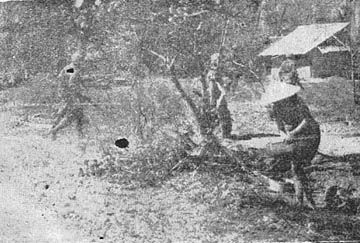 |
| UNCONCERNED - Villagers of Vinh Cu ignore members of Co. C., 1/27th Inf, and continue their work while soldiers swept through the area searching for suspected Viet Cong positions. |
Kaye Headlines Performers To Open New Theater
With the steady tat-tat-tat of division Hueys and Chinooks lofting across the
sky and the blaring salutes from nearby artillery, 2nd Bde. this week began
construction on a theater at the west end of the division helipad.
Danny Kaye will take his zany antics and wit to Cu Chi for two performances on
April 12 at 2 and 8 p. m. Luscious Vikki Carr will brighten up the stage on the
same program.
On April 16, James Drury, star of the television series "The Virginian", will
appear at the newly constructed theater. Jon Locke and Lee Burch join Drury to
provide the music and song. Dancers Lori Bigley and Jane Lyman will also be
featured. Performance time is 2 p.m. Later this month, Eddie Fisher returns to
Vietnam for his second tour. He will make a two performance stop at Cu Chi on
April 21, at 2 and 8 p.m. With Fisher this time is master wild man Buddy
Hackett and January Jones, Richard West and Kelly Garett.
Last Cackle's on You (Squawk!)
The men readied themselves for the battle. Each had the appropriate weapon
and strong rope to tie the inevitable VC prisoners. They approached their
objectives silently, the sergeant motioning for three of them to move out on the
flank. Suddenly, the platoon leader shouted, "Let's get'em!"
And with a loud shout, the men of the supply and transportation sections of
2/27th Inf. charged their own tent.
I've got one of the no-good birds, yowled a PFC as he came out of the tent
with his prisoner bound wing and foot. His captive, objecting to the
humiliating defeat, was still clucking, crowing and squawking. The prisoner,
whose many comrades were still loose in the area, was a VC - a Viet chicken.
When the Wolfhounds went to Cu Chi late in January, the villagers left in a
rush. Most took their personal belongings - all except their chickens, that is.
Now, there are over 500 of the fowl animals plaguing the valiant infantry
unit. Plaguing them so much in fact, that they claim to be the only hen-pecked
outfit in Vietnam - and there isn't a wife among them.
Since going to Hau Nghia Province many of the birds have gone the way of all
feathered flesh - into the pot or onto the grille. But eventually, even a
soldier accustomed to C rations three times a day gets tired of barbecued
chicken.
They also get tired of eggs, especially when the eggs are laid in their
sleeping bags, hats, steel helmets, jeeps and offices.
So the problem of how to rid themselves of a huge flock of chickens, while
ridding themselves of Viet Cong snipers, tunnels and mortars, fell to the men of
Headquarters Company.
Their problem was partially solved when they crated 49 of the birds and took
them to the Cu Chi village chief. The move served two purposes: it got rid of a
few more chickens, and it made the Wolfhounds kings of the nest in the village.
But still the chickens were roosting in the tents, cackling in the jeeps and,
in general, raising a squawk among the troops.
When the men started to move into wooden-frame tent kits with screen doors,
they thought their chicken problems were over. The chickens could stay - but
not with them. However, the birds weren't consulted on the arrangement and
promptly moved into the newly constructed hooches.
"It's sort of a stalemate now," said SFC Preston O'Neal, of Fulton, Mo.
"Every morning we chase then away from the hooches, out of the offices and from
under the trucks so our motor pool can operate. And, of course, we relocate a
few eggs."
So while fighting VC - Viet Cong or Viet chicken - the Wolfhounds have a real
problem: What to do with a hen that thinks your hooch is her hutch.
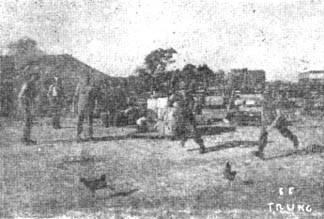 |
WHAT A CLUCK - It may not look like it, but Pfc's Robert Martin, Mattoon, Ill. , (center) and Frederick Russel, Crestline, O., are on a search-and-clear operation. Roundup time in the Wolfhound chicken coop was conducted compliments of HHC 2/27th Inf. |
Thanks to:
The 25th Infantry Division Museum for sharing the 1966 volume,
Ron Leonard, 25th Aviation Battalion for getting and mailing the book,
Kirk Ramsey, 2nd Bn., 14th Inf. for creating this page.
This page last modified 02-19-2005
©2005 25th Infantry Division Association. All rights reserved.